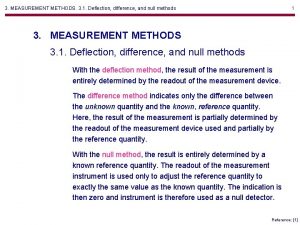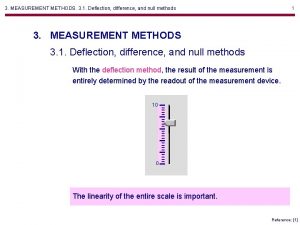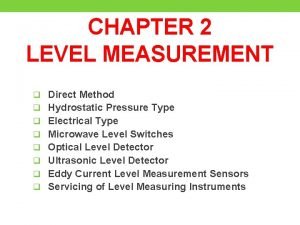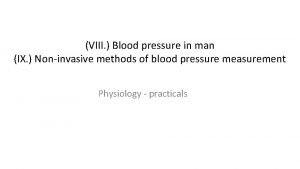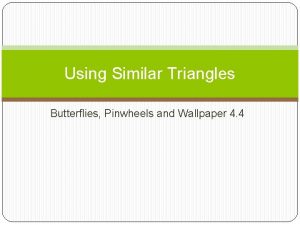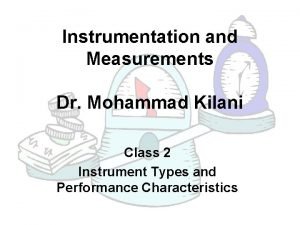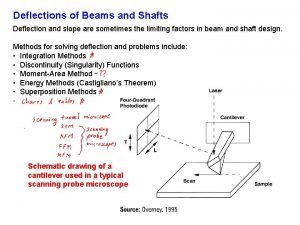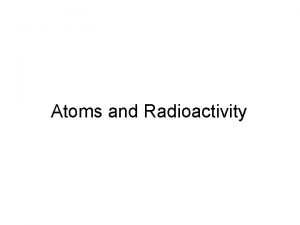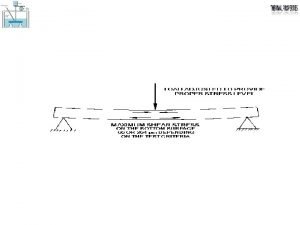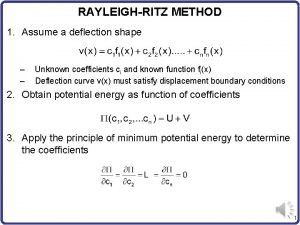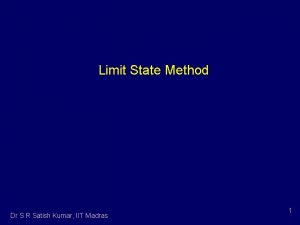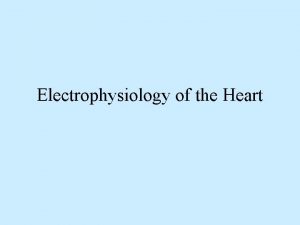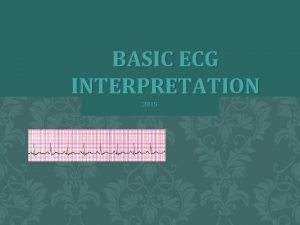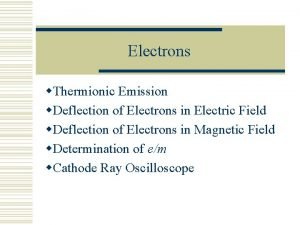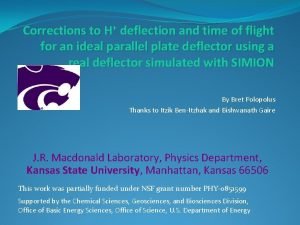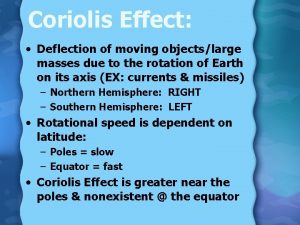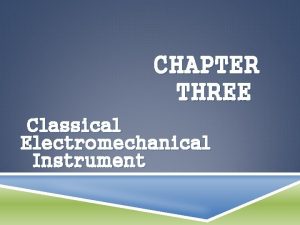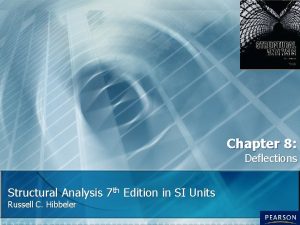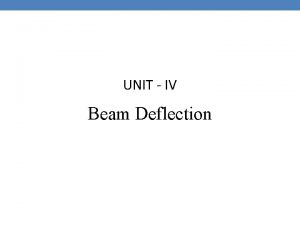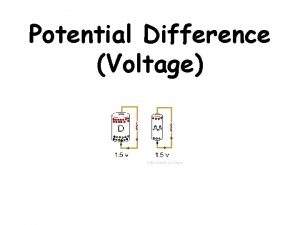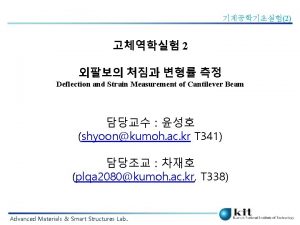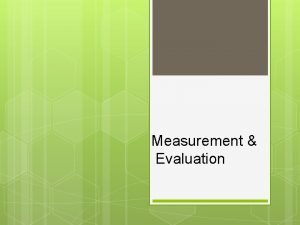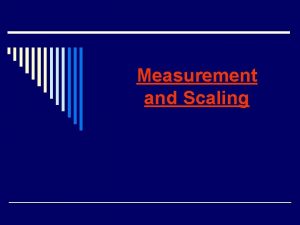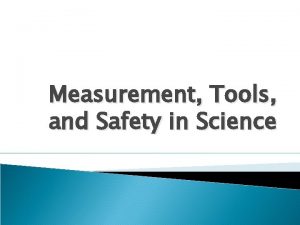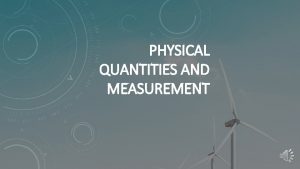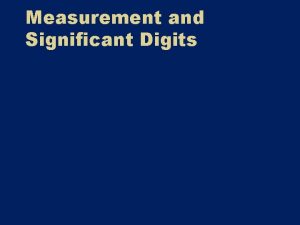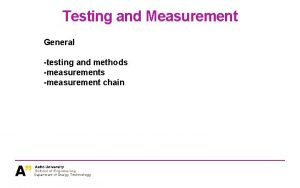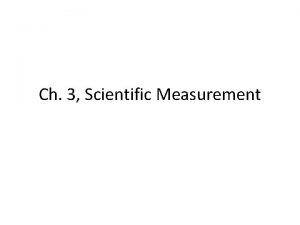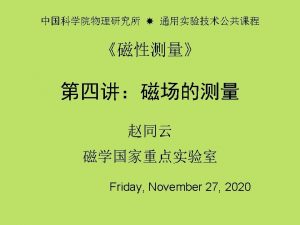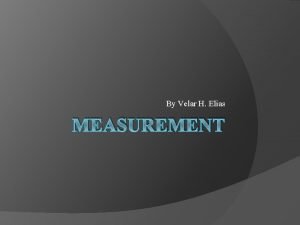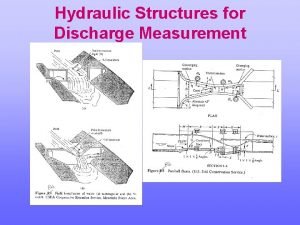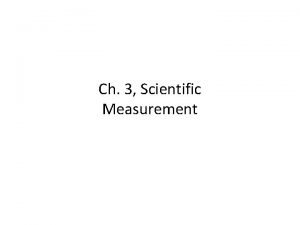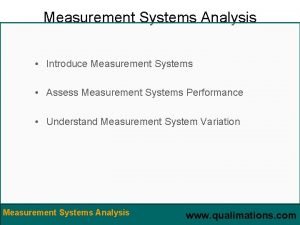3 MEASUREMENT METHODS 3 1 Deflection difference and




























- Slides: 28

3. MEASUREMENT METHODS. 3. 1. Deflection, difference, and null methods 1 3. MEASUREMENT METHODS 3. 1. Deflection, difference, and null methods With the deflection method, the result of the measurement is entirely determined by the readout of the measurement device. The difference method indicates only the difference between the unknown quantity and the known, reference quantity. Here, the result of the measurement is partially determined by the readout of the measurement device used and partially by the reference quantity. With the null method, the result is entirely determined by a known reference quantity. The readout of the measurement instrument is used only to adjust the reference quantity to exactly the same value as the known quantity. The indication is then zero and instrument is therefore used as a null detector. Reference: [1]

3. MEASUREMENT METHODS. 3. 1. Deflection, difference, and null methods 2 Example: (a) deflection, (b) difference, and (c) null measurements 0 mm ± 10 -3 1 mm ± 10 -3 0 100 mm ± 10 -3 0 0 0 100 mm (a) (b) (c) Reference 100 mm ± 10 -5 99 mm Inaccuracy: ± 100 mm ± 1 mm Null method: linearity is not important; sensitivity and zero drift are important.

3. MEASUREMENT METHODS. 3. 1. Deflection, difference, and null methods 3 Example: Null measurements, DC=0, P 0=F A Pressure, P 0 F = m·g Oil Membrane C 1 C 2 Null method: linearity is not important; sensitivity and zero drift are important.

3. MEASUREMENT METHODS. 3. 1. Deflection, difference, and null methods 4 Example: Difference measurements, P = P 0 ± DP, DP DC F = m·g Pressure, P 0 + DP Oil Membrane C 1 C 2

3. MEASUREMENT METHODS. 3. 1. Deflection, difference, and null methods 5 Example: Difference measurements, P = P 0 ± DP, DP DC Pressure, P 0 F = m·g Oil Membrane C 1 C 2

3. MEASUREMENT METHODS. 3. 1. Deflection, difference, and null methods 6 Example: Difference measurements, P = P 0±DP, DP DC Pressure, P 0 - DP F = m·g Oil Membrane C 1 C 2 Difference method: linearity is important.

3. MEASUREMENT METHODS. 3. 2. Interchange method and substitution method 7 3. 2. Interchange method and substitution method According to the interchange method, two almost equal quantities are exchanged in the second measurement. This method can determine both the magnitude of the difference between the two quantities and the magnitude of possible asymmetry in the measuring system. Example: -3 m 1 -2 -1 0 1 2 3 m 2 Reference: [1]

3. MEASUREMENT METHODS. 3. 2. Interchange method and substitution method 8 3. 2. Interchange method and substitution method According to the interchange method, two almost equal quantities are exchanged in the second measurement. This method can determine both the magnitude of the difference between the two quantities and the magnitude of possible asymmetry in the measuring system. Example: -3 m 2 -2 -1 0 1 2 3 m 1 Reference: [1]

3. MEASUREMENT METHODS. 3. 2. Interchange method and substitution method 9 3. 2. Interchange method and substitution method According to the interchange method, two almost equal quantities are exchanged in the second measurement. This method can determine both the magnitude of the difference between the two quantities and the magnitude of possible asymmetry in the measuring system. Example: -3 -2 -1 0 1 2 Offset =[1+ (-2)]/2 3 Dm =[1 -(-2)]/2 m 1 m 2 Reference: [1]

3. MEASUREMENT METHODS. 3. 2. Interchange method and substitution method 10 According to the substitution method, the unknown quantity is measured first, and the measurement system reading is remembered. Then, the unknown quantity is replaced with a known and adjustable quantity, which is adjusted to obtain the remembered reading. The characteristics of the measurement system should therefore not influence the measurement. Only the time stability and the resolution of the system are important. Example: m 2 1 0. 5 0. 2 Reference: [1]

3. MEASUREMENT METHODS. 3. 2. Interchange method and substitution method 11 According to the substitution method, the unknown quantity is measured first, and the measurement system reading is remembered. Then, the unknown quantity is replaced with a known and adjustable quantity, which is adjusted to obtain the remembered reading. The characteristics of the measurement system should therefore not influence the measurement. Only the time stability and the resolution of the system are important. Example: m 2 1 0. 5 0. 2 Reference: [1]

3. MEASUREMENT METHODS. 3. 2. Interchange method and substitution method 12 According to the substitution method, the unknown quantity is measured first, and the measurement system reading is remembered. Then, the unknown quantity is replaced with a known and adjustable quantity, which is adjusted to obtain the remembered reading. The characteristics of the measurement system should therefore not influence the measurement. Only the time stability and the resolution of the system are important. Example: 2 m 1 0. 5 0. 2 Reference: [1]

3. MEASUREMENT METHODS. 3. 2. Interchange method and substitution method 13 According to the substitution method, the unknown quantity is measured first, and the measurement system reading is remembered. Then, the unknown quantity is replaced with a known and adjustable quantity, which is adjusted to obtain the remembered reading. The characteristics of the measurement system should therefore not influence the measurement. Only the time stability and the resolution of the system are important. Example: Calibration 3. 5 m=3. 5 2 2 m 0. 5 1 1 1 0. 5 0. 2 Reference: [1]

3. MEASUREMENT METHODS. 3. 2. Interchange method and substitution method 14 Example: Interchange method. Linear differential amplifier with offset Vo Vo =+A(Voff +Ve ) Voff Ve Va A V 0 V'o A·Voff Va-Vb Vb Vo =+A(Voff +Va-Vb) Voff =? Ve

3. MEASUREMENT METHODS. 3. 2. Interchange method and substitution method 15 Example: Interchange method. Linear differential amplifier with offset Vo =+A(Voff +Ve ) Vo V'o Voff Ve Va Vb A(Va-Vb) A V 0 Va-Vb V''o =A·V (V'o+V''o)/2= A·V off (V'o-V''o)/2=A =A(Va-Vb) Ve A·Voff

3. MEASUREMENT METHODS. 3. 2. Interchange method and substitution method Example: Amplifiers with the controllable polarity of the gain 10 k ± 1% Voff Vin 5 k 5 k 10 k ± 1% Voff Vin 5 k 16

3. MEASUREMENT METHODS. 3. 2. Interchange method and substitution method Example: Amplifiers with the controllable polarity of the gain 10 k ± 1% Voff Vin 5 k ±? 17

3. MEASUREMENT METHODS. 3. 2. Interchange method and substitution method 18 Example: Interchange method. Level measurement Dmsr 2 D D=? Offset =? 1° Dtrue

3. MEASUREMENT METHODS. 3. 2. Interchange method and substitution method 19 Example: Interchange method. Level measurement Dmsr Offset = (2° - 1°)/2 = 0. 5° D = (2° + 1°)/2 = 1. 5° 2 1 D 1° Dtrue

3. MEASUREMENT METHODS. 3. 2. Interchange method and substitution method Example: Interchange method. Level measurement Offset = 0. 5° 1° D = 1. 5° 20

3. MEASUREMENT METHODS. 3. 2. Interchange method and substitution method 21 Example: Substitution method. Calibration of a measurement system is, in fact, an application of the substitution method. First the system is calibrated with a know quantity. An unknown quantity can then be measured accurately if its magnitude coincides with the calibrating points. Two next measurement methods, compensation and bridge methods, are also, in fact, applications of the substitution method. Reference: [1]

3. MEASUREMENT METHODS. 3. 3. Compensation method and bridge method 22 3. 3. Compensation method and bridge method Compensation method removes the effect of unknown quantity on the measurement system by compensating it with the effect of known quantity. The degree of compensation can be determined with a null indicator. If the unknown effect is compensated completely, no power is supplied or withdrawn from the unknown quantity. The compensation method requires an auxiliary power source that can supply precisely the same power that otherwise would have been withdrawn from the measured quantity. Reference: [1]

3. MEASUREMENT METHODS. 3. 3. Compensation method and bridge method 23 Example: Measurement of voltage with compensation method Null detector (1 -a) R Vx Vx = a. Vref a. R Reference: [1]

3. MEASUREMENT METHODS. 3. 3. Compensation method and bridge method 24 NB: Note that the difference method and the null method make use of the compensation method. In the difference method, the compensation is only partial, whereas in the null method it is complete. 0 0 Reference No compensation Partial compensation Complete compensation Reference: [1]

3. MEASUREMENT METHODS. 3. 3. Compensation method and bridge method 25 Bridge method (Christie, 1833, Wheatstone, 1843) Null detector (1 -a) R Vref Vx = a. Vref a. R Vref Rx a. R R R Vref Originally was called ‘the bridge’ It can be shown that the null condition does not depend on the power delivered by the power supply, the circuits internal impedance or the internal impedance of the null detector. Note that the bridge method requires a single power source. Reference: [1]

3. MEASUREMENT METHODS. 3. 4. Analogy method makes use of a model of the object from which we wish to obtain measurement information. The following models can be used. Mathematical models (simulations). Scale models (e. g. , acoustics of large halls, etc. ). Non-linear scale models (e. g. , wind tunnel models, etc. ). Analogy method also widely uses the analogy existing between different physical phenomena, for example, equivalent mechanical models are used to model electrical resonant circuits, equivalent electrical models are used to model quartz resonators, equivalent magnetic circuits are used to model magnetic systems, etc. 26

3. MEASUREMENT METHODS. 3. 5. Repetition method 27 3. 5. Repetition method Wit this method several measurements of the same unknown quantity are conducted each according to a different procedure to prevent the possibility of making the same (systematic) errors, specific to a certain type of measurements. Different (correctly applied) methods of measurements will provide similar results, but the measurement errors in the results will be independent of each other. This will yield an indication of the reliability of measurements. 6 7 8 9 10 9 8 7 6 6 7 8 9 10 9 8 7 6 Unreliable Reliable Valid Reference: [1]

Next lecture 28 Next lecture:
 Deflection method of measurement
Deflection method of measurement Deflection method of measurement
Deflection method of measurement Hemoglobin measurement methods
Hemoglobin measurement methods Cyanmethemoglobin method
Cyanmethemoglobin method Hook type level indicator
Hook type level indicator Aortic pressure curve
Aortic pressure curve Butterflies pinwheels and wallpaper
Butterflies pinwheels and wallpaper Direct wax pattern technique
Direct wax pattern technique Vertical deflection
Vertical deflection Null type and deflection type instruments
Null type and deflection type instruments Deflection of beams and shafts
Deflection of beams and shafts Gamma emission equation
Gamma emission equation Slope deflection
Slope deflection Open method and bracketing method
Open method and bracketing method Oxygen index
Oxygen index Rayleigh-ritz method cantilever beam example
Rayleigh-ritz method cantilever beam example Cladding deflection limits
Cladding deflection limits Cdi deflection distance
Cdi deflection distance Rythme agonal ecg
Rythme agonal ecg Intrinsicoid deflection ecg
Intrinsicoid deflection ecg Deflection requirements
Deflection requirements Why is the q wave a negative deflection
Why is the q wave a negative deflection Modified scheie classification
Modified scheie classification Charge of electron
Charge of electron Simion 0408
Simion 0408 Coriolis force animation
Coriolis force animation Deflection
Deflection Deflection instrument
Deflection instrument Deflection
Deflection
